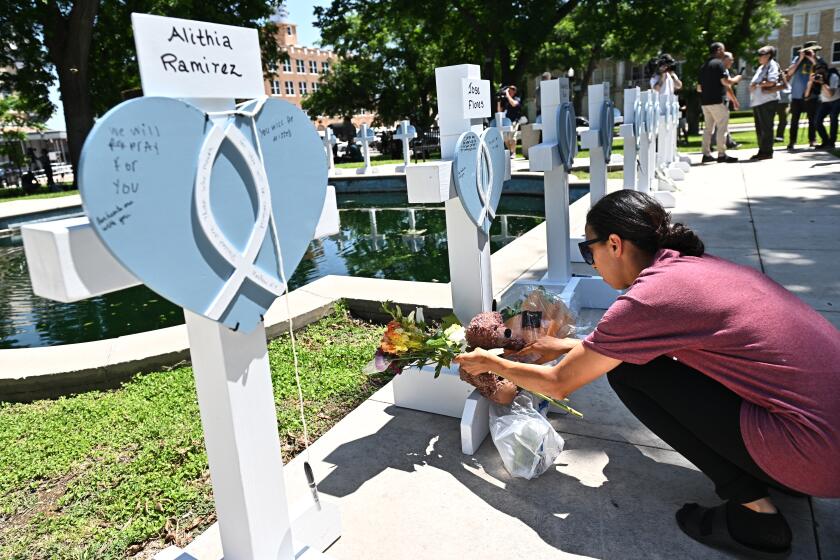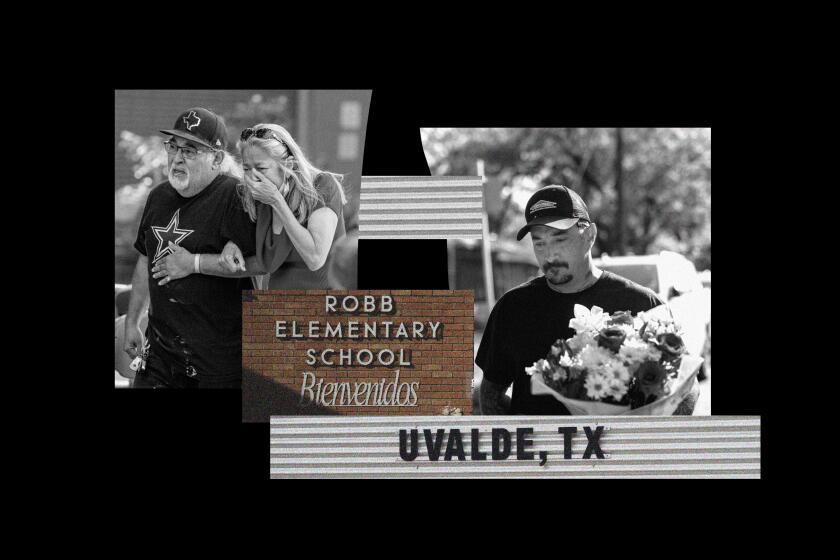How a devastating short film about a school shooting is becoming a graphic novel

- Share via
When Will McCormack and Michael Govier set out to write and direct a short animated film about a couple mourning their child, they had no idea it would become a viral hit and win an Academy Award. But they did know they also wanted to turn it into a book.
“If Anything Happens I Love You,” the film, opens on two parents sitting apart in the throes of an unnamed grief. Over 10 wordless minutes we realize their daughter has died in a school shooting. The short, which won an Oscar for animated short in 2021, found its force in suggestive vignettes illustrated by Youngran Nho. The graphic novel the co-directors conceived would tell the same story very differently. Instead of blacks and grays permeating the screen, they wanted the book painted in blues, greens and yellows celebrating a child’s life. This time there would be words, and they would be spoken by the girl who was lost.
“Everyone talks about the day I died, which is a shame. Because they never talk about how I lived. People say I was only twelve years old. But it was my twelve years. And I lived a lot. Hi, I’m Rose.”
So begins the graphic novel, which will be published in September by Andrews McMeel. Speaking from the afterlife, Rose narrates what she misses about life on Earth: Arnold, her black cat; jamming with dad; eating mom’s food. She tells us about her favorite teacher, Ms. Rivera, and Lucas, her first boyfriend; about her family’s epic trip to the Grand Canyon; and the time she damaged the side of the house with a soccer ball.
As in the film, the shooting itself is offscreen. What matters is her life and the aftermath of her death.

“Inexorably, so many times with these tragedies, the focal point becomes the tragedy itself,” McCormack said in a video interview last month. “And this story is not not about the tragedy, but it’s also about her life and the story that she wants to tell, how she lived and what was meaningful to her, and I think that often gets lost in the news.”
The film and forthcoming book became horrifically relevant again in recent days. Last Tuesday, an 18-year-old gunman barged into a Texas elementary school and killed 19 children and two teachers in one of the deadliest school massacres in U.S. history. Once again — as after the killings at Santa Fe and Marjory Stoneman Douglas high schools, Sandy Hook Elementary School and so many other campuses — the country is grieving boys and girls senselessly murdered. Once again, some politicians are begging for gun control with little hope of lasting change. And once again, parents are left on the sidelines to mourn and to rebuild shattered lives as best they can.
The names and stories of those killed in the Texas school shooting are emerging as the stunned community of Uvalde tries to cope with Tuesday’s attack.
This grim contemporary American reality is far removed from the experiences Govier, McCormack and Nho had growing up.
“Gun violence itself is something that’s new to me, because in Korea there’s not much of that kind of tragedy,” said Nho, who moved to the U.S. eight years ago.
“All we had were fire drills,” recalled Govier, 44, who grew up in Redding, Calif. “We didn’t have active shooter drills. … The fact that this fear exists within this current community is so shocking, so we wanted to highlight the effect of gun violence on one family” — hoping, he said, that it would lead to larger conversations.
The film certainly did. When the short was released on Netflix in November 2020, it instantly became a viral sensation.
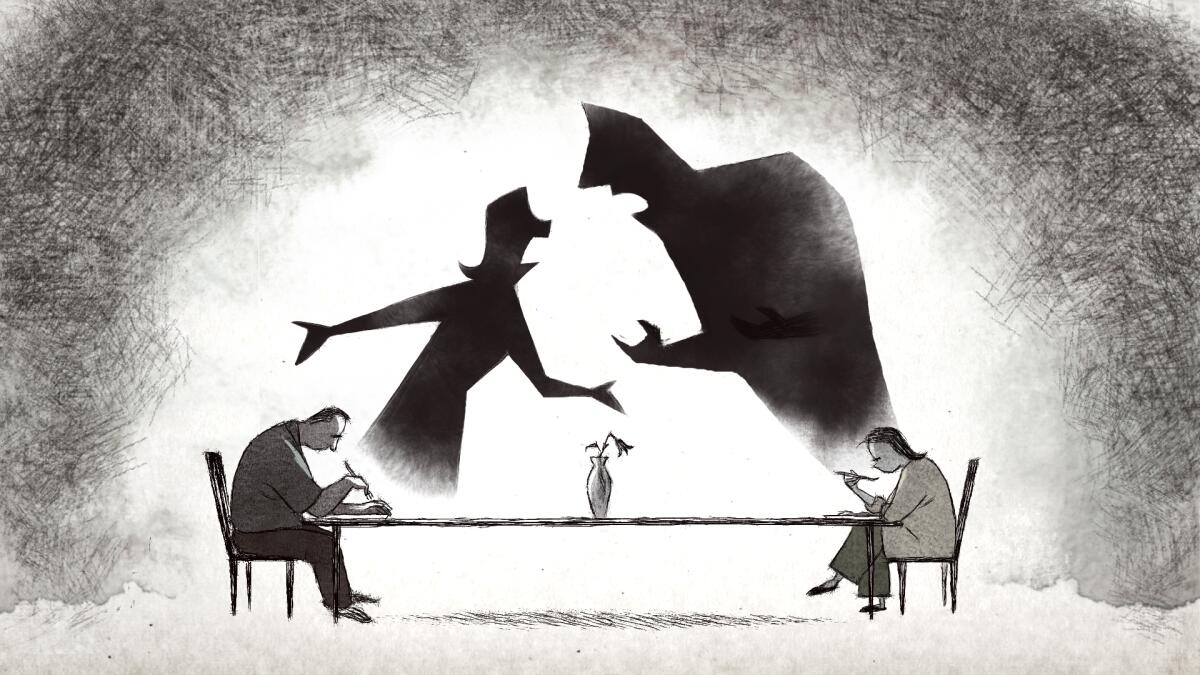
The hashtag “#ifanythinghappensiloveyou” became a TikTok challenge, racking up more than 31 million views on the social media platform in its first week. Participants would record themselves before and after watching the 12-minute short, trying not to cry. It won the Oscar a few months later.
The short depicts Rose’s parents’ detachment and withdrawal from each another, their isolation and their memories triggered by mundane tasks or something as simple as a T-shirt. Interwoven are flashbacks of the family’s happy life and the devastating event that shattered it: As gunfire and screams intensify, Rose texts her last words to her mom and dad: “If anything happens I love you.”
McCormack has a simple explanation for why the film resonated so widely: “Kids are getting shot in schools and nothing has changed.”
“In the same way that people felt seen and heard with the film,” he continued, “I hope they feel understood reading the book — that they are not alone, that their life matters, and that this story needs to be told again and again, and you obviously can’t talk about it enough because it keeps happening.”
The idea for the graphic novel arose early on as the filmmakers were crafting a script. Exploring and researching grief, they knew there was more story to tell.
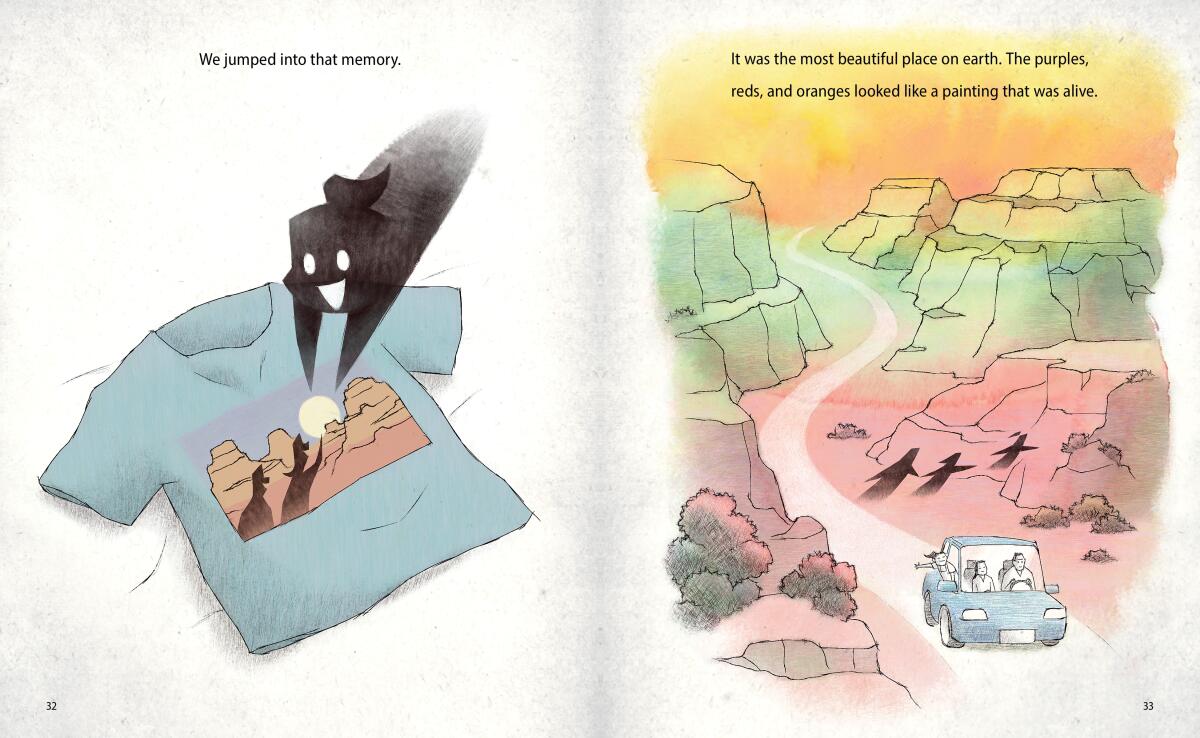
By the time they completed the short, they had gotten to know Rose intimately: They knew the music she liked, the memories she cherished most, the people who meant the world to her. The book’s new perspective also allowed them to introduce new characters, like Ms. Rivera, and expand others, like Rose’s first crush.
Though they kept the film’s minimalist visual style, the creators added more layers, textures and colors to the illustrations. The biggest challenges for Nho, a CalArts graduate whose first credit was the film, were working with prose and deciding on a single image that would best capture the emotions on the page.
She found herself spending more time choosing illustrations than drawing them. Nho said she drew an average of 10 images for every page before showing them to Govier and McCormack for feedback.
Then there was the question of how much writing to include as they adapted a film with no words at all.
“We started by thinking, ‘How can we tell a story with as few words as possible?’” said Govier, “and we realized we needed to add a lot more prose to connect you on the page, to guide the reader through, especially as we shift perspectives.”
Those shot and killed in Uvalde died in the most American way possible — in a senseless mass shooting at a school.
After the short was released, Govier and McCormack finally had time to focus on the book. They started pitching to publishers in 2021, but the response rarely varied: “‘We love it, but it’s too sad and we don’t know if people want this kind of book about grief,’” Govier recalled hearing repeatedly. Finally they met Patty Rice, an editor who believed in its potential. They sold the book to Andrews McMeel that year in a deal brokered by United Talent Agency, which represents the filmmakers. The deal for an unusual type of adaptation, from film to book, was sealed.
Rice, the book’s editor, was initially struck by the book’s hopefulness, but it was a tough sell within the publishing house. “Everybody kept saying, ‘It’s so sad,” she recalled. But she understood that it filled a need.
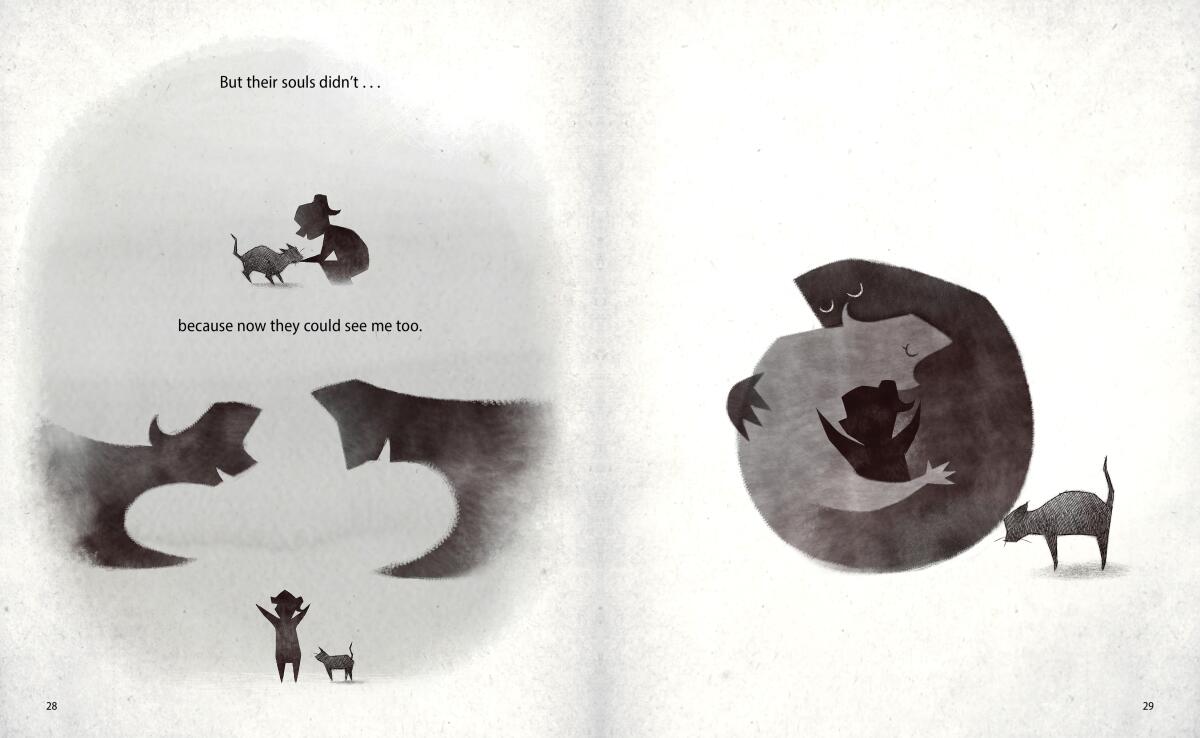
“Yes it’s sad, but how do you think the parents of kids who’ve been killed at school feel?” she said. “Yes, it’s sad, but that doesn’t mean it’s not reality, and that doesn’t mean that we can’t find tools to help kids and families work through grief.”
That is what the filmmakers-turned-authors hope the book becomes — a resource for families to talk about loss — in part by putting the power of their graceful, silent, grim but oddly consoling film into words.
“For all those lost and for all those left behind,” reads the book’s dedication, which is followed by the proverb: “When a parent dies,/ you bury them in the ground./ When a child dies,/ you bury them in your heart.”
More to Read
Sign up for our Book Club newsletter
Get the latest news, events and more from the Los Angeles Times Book Club, and help us get L.A. reading and talking.
You may occasionally receive promotional content from the Los Angeles Times.
